Apologies if this sounds like a newbie question. I've just changed caps on Wharfedale Diamond III bookshelf speakers after changing blown tweeters some time back to 6Ohm PSB units. On my speakers the high pass consisted of 6uF and a 2.2uF in series, with resultant capacitance of about 1.6uF. This would appear to give a crossover frequency of in excess of 7000Hz with 8Ohm tweeter, yet the label on the back claims 5000Hz. I've seen pictures of different Diamonds and they've had 4.7 and a 3.3uF caps, not sure if in series or parallel.
In any case I put 4.7uF (actual value 4.9) caps in because tables suggested 5.3uF for 6Ohm tweeter with 8Ohm woofer and I had the 4.7s on hand (and I live a long way from any electronics outlet). I also changed the 450uF caps on the "low pass'' which apparently (according, again, to the label) give "5th order" characteristics to the crossover, but I've read it's mainly to protect the woofer. The new caps checked out at around 480uF (my multimeter only goes to 200 so I had some maths to work out with a known sub-200 cap in series).
Anyway the sound seems to be improved, which was the point of the exercise. Have I made any mathematical errors?
In any case I put 4.7uF (actual value 4.9) caps in because tables suggested 5.3uF for 6Ohm tweeter with 8Ohm woofer and I had the 4.7s on hand (and I live a long way from any electronics outlet). I also changed the 450uF caps on the "low pass'' which apparently (according, again, to the label) give "5th order" characteristics to the crossover, but I've read it's mainly to protect the woofer. The new caps checked out at around 480uF (my multimeter only goes to 200 so I had some maths to work out with a known sub-200 cap in series).
Anyway the sound seems to be improved, which was the point of the exercise. Have I made any mathematical errors?
6uF and 2.2uF in series is just a bit odd. It does of course make an overall 1.5uF or so. Fairly typical cheap and cheerful high first order tweeter crossover. 1.5uF to 2.2uF in series with tweeter is common enough and protects tweeter from low frequencies.
Such low slope that crossover point is almost meaningless and depending on the woofer rolloff.
The series 450uF low pass is designed to protect the woofer from subsonics. It may well have a 1mH series coil too, to boost the bass performance. Well, actually it rolls off the woofer in the midrange, which has the effect of making the bass relatively louder.
I think I used to have this tiny 2 way speaker. Lively performance if a bit ragged. Quite nice.
Such low slope that crossover point is almost meaningless and depending on the woofer rolloff.
The series 450uF low pass is designed to protect the woofer from subsonics. It may well have a 1mH series coil too, to boost the bass performance. Well, actually it rolls off the woofer in the midrange, which has the effect of making the bass relatively louder.
I think I used to have this tiny 2 way speaker. Lively performance if a bit ragged. Quite nice.
Thanks Steve, yes, there is a 1.8mH coil, there (at least, that's what I measured it at). I have two other pairs of Wharfedale speakers (510s, which had issues, now sorted) and some 70s Lintons, which I gutted and replaced drivers and crossovers. While I didn't listen to the Lintons (only wanted the cabs to reduced the need for woodworking, not one of my strong points) the Diamonds and 510s have always astounded me in that they sound pretty good to my ears yet appear quite shoddily made in some respects. I bought the Diamonds and 510s new in 1989. They've been through a lot, including salt air and mouse infestation on a remote island. The Linton crossovers looked like they'd been thrown together with WWII bits, in 5 minutes.
I can only surmise that Wharfedale had a good supply of 6 and 2.2uF caps lying around when they put the Diamond IIIs together. They are the blue "Alcap" brand I've seen in other Wharfedales (pics online and the 510s).
I had a great couple of weeks in and around Portsmouth in '77, Queen's Silver Jubilee. It's remarkable that Elizabeth has passed Gold and Diamond and has been queen my entire life (and I'm approaching 60 ).
).
I can only surmise that Wharfedale had a good supply of 6 and 2.2uF caps lying around when they put the Diamond IIIs together. They are the blue "Alcap" brand I've seen in other Wharfedales (pics online and the 510s).
I had a great couple of weeks in and around Portsmouth in '77, Queen's Silver Jubilee. It's remarkable that Elizabeth has passed Gold and Diamond and has been queen my entire life (and I'm approaching 60
Isn't that funny! I used some Linton cabinets for a complete rebuild too. Very solid! 
If you're interested, there are some better tweeters around that might fit a small space:
Morel Classic CAT408
Monacor DT-28N
It's not hard to add an attenuator circuit to get levels right with wirewound resistors. I certainly like those little plastic bass units. You can stick rubbery carpet underlay on the sides too for the BBC sound.
Replacement capacitors are easy too:
Alcap 50V Low Loss Electrolytic capacitors for all audio and hi-fi loudspeaker crossover applications
I realise you're not in the UK, but you get the idea?
If you're interested, there are some better tweeters around that might fit a small space:
Morel Classic CAT408
Monacor DT-28N
It's not hard to add an attenuator circuit to get levels right with wirewound resistors. I certainly like those little plastic bass units. You can stick rubbery carpet underlay on the sides too for the BBC sound.
Replacement capacitors are easy too:
Alcap 50V Low Loss Electrolytic capacitors for all audio and hi-fi loudspeaker crossover applications
I realise you're not in the UK, but you get the idea?
Thanks for the links, Steve. I used some small (much smaller the the Wharfedale purple things) Miller and Kreisel buyout tweeters from the US in the Lintons, with some 6.5" carbon fibre woofers from a company here in Au/NZ called Jaycar. The original Linton 8" woofers had been replaced with cheap Jaycar-branded units, mounted at the rear of the baffle. I mounted the new drivers from the front, with a small ring to fill out the (surprisingly small) hole and rebated slightly so I could retain the Linton grilles.
These speakers were meant to be a reasonably cheap way to fill out the 7.1 set for AV, realising of course that one can buy cheap Chinese stuff even in my local electrical shop or from Ebay, but I wanted something I had made/assembled myself. The carbon woofers I had anyway, 4Ohm and designed more for car use although extremely heavy (despite the carbon fibre ).
).
I hadn't thought that Alcap caps were still around (so many great British companies having folded) so will bookmark the site for future cap needs. I have bought some stuff out of UK, as with US postage can be really scary, especially for large drivers, but quite reasonable (at least for small/light goods) out of UK. And, the service so far has always been friendly unlike some of my contact with US sellers.
These speakers were meant to be a reasonably cheap way to fill out the 7.1 set for AV, realising of course that one can buy cheap Chinese stuff even in my local electrical shop or from Ebay, but I wanted something I had made/assembled myself. The carbon woofers I had anyway, 4Ohm and designed more for car use although extremely heavy (despite the carbon fibre
I hadn't thought that Alcap caps were still around (so many great British companies having folded) so will bookmark the site for future cap needs. I have bought some stuff out of UK, as with US postage can be really scary, especially for large drivers, but quite reasonable (at least for small/light goods) out of UK. And, the service so far has always been friendly unlike some of my contact with US sellers.
The Diamond III crossover is 18dB/8ve. There'll be a 0.2mH air cored inductor between the 2 caps & earth.
Don't bother trying to get values for classic filter circuits. The better speaker makers stopped doing that in the 70s and designed the xovers to match the units/box response.
Shame about your blown trebles. Are they the ones with a rectangular faceplate with rounded sides?
These are some of my favourite treble units. The diaphragm material is now Unobtainium.
Don't bother trying to get values for classic filter circuits. The better speaker makers stopped doing that in the 70s and designed the xovers to match the units/box response.
Shame about your blown trebles. Are they the ones with a rectangular faceplate with rounded sides?
These are some of my favourite treble units. The diaphragm material is now Unobtainium.
These are some of my favourite treble units. The diaphragm material is now Unobtainium.
Actually it's not too hard to find plastic dome tweeters really:
DT 94 - 8 Ohm
DTW 72 - 8 Ohm
Vifa D19TD-05 3/4" Poly Dome Tweeter 264-500
I'm not too sure they are really all that good though. Just bright.
The Diamond III crossover is 18dB/8ve. There'll be a 0.2mH air cored inductor between the 2 caps & earth.
Don't bother trying to get values for classic filter circuits. The better speaker makers stopped doing that in the 70s and designed the xovers to match the units/box response.
Shame about your blown trebles. Are they the ones with a rectangular faceplate with rounded sides?
These are some of my favourite treble units. The diaphragm material is now Unobtainium.
Yes, there is a small inductor (I measured at 1.8 mH, but my meter is a cheap one) in the circuit.
I don't know if tweeters can "blow" as comprehensively as these ones (well, one of them at least) did. I pulled the grille off because the tweeter wasn't working- to find ferrofluid leaking in quite disturbing amounts. I opened the cab, to find that the magnet had actually fallen off the faceplate and was attached to the woofer's magnet. The tweeters are "truncated" i.e. a flattened circle, with a dome a little under 25mm.
The PSB units I obtained from US are aluminium-domed and a little "bright". My circuit would have differing requirements now with that 6Ohm tweeter. In retrospect the Dayton 8Ohm truncated plate units would have been a better fit. Anyway the Diamonds do sound better to my ear with a new 4.7Uf cap replacing the series 6 & 2.2UF caps, which were approaching 25 years in age, too.
I'd reckon Cooktown is a more pleasant place to be at the moment than where I am in western NSW. A week of 38-44C temps has left me frazzled, trying to catch up on outdoors chores now the temp's back to 32C- still drenched in sweat.
Plastic dome treble units are not created equal. I worked on that unit at Wharfedale.Actually it's not too hard to find plastic dome tweeters really:
hello.
in this thread there is something about wharfedale crossovers......(post12, 16,....)
http://www.diyaudio.com/forums/parts/224251-vintage-capacitor-help-identify-2.html#post3266730
in this thread there is something about wharfedale crossovers......(post12, 16,....)
http://www.diyaudio.com/forums/parts/224251-vintage-capacitor-help-identify-2.html#post3266730
Plastic dome treble units are not created equal. I worked on that unit at Wharfedale.
Aw, come off it! Secret sauce added, I suppose....No, I'm not having it. Tweeters are tweeters.
The Monacor DT19-SU is a current polydome that people seem to like.
An externally hosted image should be here but it was not working when we last tested it.
Rather similar to the KEF T27 IMO.
System, if you believe that, you'll believe 'xovers are xovers' and the classic filter stuff can be used for all treble units.Aw, come off it! Secret sauce added, I suppose....No, I'm not having it. Tweeters are tweeters.
I worked for KEF too. There were several different versions of T27, some of which look the same to anyone not versed in the art. I'm sure your views will interest all current and former drive unit designers and manufacturers ... and the system designers too.Rather similar to the KEF T27 IMO.
BTW, I'm not dissing the Monacor units. They may well be excellent. But there is a lot of important stuff that never appears in a spec sheet. Not that its of interest to you cos 'Tweeters are tweeters'.
Last edited:
kgrlee, you doubtless know a thing or two about tweeters, but to imply your own design was without peer is just a tease. Tell us about it so DIYers can find some good substitute rather than just try to look clever. Seems to me you just mix up magnets, coils and domes and ferrofluid and materials in different proportions and sizes really. 
Robin Marshall doesn't find it hard, and like most people who really know what they are talking about, can explain it simply:
I find his notion that cone tweeters might work better interesting too:
So what is good about that little plastic Wharfedale cheapie? I would add that I used to have this speaker, and liked it.
Robin Marshall doesn't find it hard, and like most people who really know what they are talking about, can explain it simply:
Atkinson: I said earlier that you make your own drive-units, including the 26mm dome for the ES-14 and the 32mm for the old '20. I've always been told that tweeter manufacture is fraught with problems because of the very close tolerances required on something so small. You went into that . . .
Marshall: Foolishly.
Atkinson: Did it take you a long time to get a good tweeter into production?
Marshall: No, not really, because it's just an engineering problem. There's nothing difficult really about it. The only difficulty in making a tweeter is that all the masses are so low you've got to be very careful with adhesive bonding to make sure you're not changing the masses of things and introducing compliances. It's only an engineering problem. There's nothing difficult in licking that, providing you have the experience and the resources to do it. I think most people are scared off unnecessarily. Most manufacturers say "Well, we can make a bass driver, but a tweeter, hmm, no." They've never tried it.
I find his notion that cone tweeters might work better interesting too:
Atkinson: You're probably aware that metal-dome tweeters are controversial here in the USA, with many designers feeling that their advantages are only obtained at the expense of problems elsewhere. What are the specific reasons you chose to use them?
Marshall: Let me first of all say that I'm beginning increasingly to think that dome tweeters might not be the best way of doing things. I'm beginning to think more and more that, should we not be looking at cone rather than dome tweeters? But having decided that you're going to make a dome tweeter, you want at least to keep the diaphragm bending modes out of the audio passband. And there is no other material, no usable material, other than a metal, where that is possible. You could probably make a tweeter diaphragm out of ceramic, which would be, perhaps, quite wonderful, but the prospect of making it is daunting.
So what is good about that little plastic Wharfedale cheapie? I would add that I used to have this speaker, and liked it.
System, I didn't say it was without peer. I said it was one of my favourites. You may be aware that Celestion & Wharfedale made some of the best metal dome treble units too. Celestion was the first. The same people were involved with both companies.kgrlee, you doubtless know a thing or two about tweeters, but to imply your own design was without peer is just a tease.
Wharfedale also made a good ceramic dome treble unit and yes, it has the advantages that Robin Marshal ascribes to it including the daunting manufacture
I wish it was that simple. I've been a beach bum for more than a decade so have no flag to wave for any company but still have friends in the major UK manufacturers.Tell us about it so DIYers can find some good substitute rather than just try to look clever. Seems to me you just mix up magnets, coils and domes and ferrofluid and materials in different proportions and sizes really.
All of them would find your beliefs amusing.
I'm not sure you get anything useful about how to choose a treble unit from his interview.Robin Marshall doesn't find it hard, and like most people who really know what they are talking about, can explain it simply:
The secret sauce was the diaphragm material. As it is the secret sauce in our bass units. [*] Both materials are now UnobtainiumSo what is good about that little plastic Wharfedale cheapie? I would add that I used to have this speaker, and liked it.
I could bore you with the Scanned Laser Doppler Interferometry and FEA work that led to the specification of the material but then you would accuse me of showing off.
Let me tell instead, what I'd do if I was starting manufacture again in a small way. I'd look at what was available from the better Far East manufacturers. I'd want to visit their factories and talk QC with them. Certain factories in Guangzhou make some of the most consistent units in the world since the demise of the Wharfedale Leeds factory. I know, cos I helped set some up more than a decade ago.
After choosing suitable examples for test, I'd measure them for response, distortion & directivity. The leading contenders would be tried with matched xovers in the system I was working on. Discuss small changes with the factory to ensure anything requested tied in with their manufacture & quality.
I'm sorry if this isn't much help to a DIYer but I wouldn't have spoken up at all except your statements that
- 'Tweeters are tweeters' and
- the implication that standard filter circuits for xovers are OK
Try Design of Optimized Loudspeaker Crossover Networks Using a Personal Computer for some of the issues.
I spent most of my previous life trying to understand speakers but I'm not sure I'm any better suited to pick a drive unit from info on the internet.
Of course I have my own prejudices which would influence what I'd choose to look at first. Practically any treble unit of the right sensitivity that fits in the hole could be made to 'work' PROVIDED you had some means of providing the information to a programme like Schuck's. But that isn't a guarantee that it would sound good.
[*] There are other important ingredients like the way they are assembled but none of it is relevant today as the units are Unobtainium.
Hi,
The simple fact is mixing and not matching replacement bass units
and tweeters with the original croosover is just hoping that it works.
You don't know if it will work well and what problems may be lurking.
Replacing tweeters generally though isn't too problematic. 3rd order
electrical at 5KHz will suit smaller cheaper types very well like the
Dayton ND20 or HiVi T20, no real point going bigger / "better".
(Or the classic Audax used in the earlier Diamond.)
rgds, sreten.
Is more likely the x/o is worse than better, if you change
component values based on false premises, I'd sim it using
TinaTi to see what you done to the 3rd order roll-off.
The simple fact is mixing and not matching replacement bass units
and tweeters with the original croosover is just hoping that it works.
You don't know if it will work well and what problems may be lurking.
Replacing tweeters generally though isn't too problematic. 3rd order
electrical at 5KHz will suit smaller cheaper types very well like the
Dayton ND20 or HiVi T20, no real point going bigger / "better".
(Or the classic Audax used in the earlier Diamond.)
rgds, sreten.
Is more likely the x/o is worse than better, if you change
component values based on false premises, I'd sim it using
TinaTi to see what you done to the 3rd order roll-off.
Last edited:
The Diamond III crossover is 18dB/8ve. There'll be a 0.2mH air cored inductor between the 2 caps & earth.
The 1.8mH will look like L1 in this pic. The 0.2mH will look like L3.Yes, there is a small inductor (I measured at 1.8 mH, but my meter is a cheap one) in the circuit.
http://www.deviantpics.com/images/2012/11/30/2.jpg
The Diamond 3 xover is similar to Laser 90B but without the 0.05mH inductor. In its place may be a small resistor.
If the 0.2mH is missing, you need to replace it. If the treble units were blown, the treble capacitors will probably be blown too.
As sreten says, none of this is likely to give the correct response except with the genuine Wharfedale unit.
But it will be better than 6dB/8ve xovers (without the 0.2mH) which are truly evil.
Kgrlee, I've gotta say that it is very enjoyable to talk to you online. Evidently you are one of the last people who believed that Britain was founded as a manufacturing nation, and that Mrs. Thatcher (Gawd bless her in most respects, a politician who had actually had a real job at some stage...) was totally wrong in killing off our factories. 
I used to bump into Sir John Harvey-Jones, Chairman of ICI and lover of bright ties, on a regular basis. It was always his belief that REAL WEALTH is created by MANUFACTURING alone. Sound man.
I just "crunched some numbers" on the Wharfedale Laser 90B speaker in the thoroughly modern Visaton Boxsim simulator.
Pretty awful filter, TBH, though it might work with a valve amp. That coil at the tweeter input is just not good. I used the plastic dome DT-94-8 ohm which has a phase plate to correct the typical frequency peak around 10kHz of plastic domes. The Monacor DT-19SU behaves predictably for another plastic dome without phase plate. Usually you notch this one electrically instead.
Tweeter ARE tweeters. Filters depend on circumstances. Your plastic Wharfedale jobbie was OK as it goes. I enclose some pictures, worth a thousand words, of one that fell apart.
The last image is a Robin Marshall design AFAIK. Plastic bass, metal tweeter with diffuser. Dig that convex tweeter mounting plate.
There is a bit of a hierarchy in speaker materials. Broadly plastic is well damped and slow and gets away with simple filters, paper optimal, and metal fast and buzzy needing great attention with filters to be well behaved.
I modelled a Visaton W170S paper bass and very efficient DT-94 plastic tweeter here. Quite nice really, but as I said, I have doubts if plastic tweeters are really all that satisfying though they are inoffensive. But they will integrate nicely with a plastic bass.
I used to bump into Sir John Harvey-Jones, Chairman of ICI and lover of bright ties, on a regular basis. It was always his belief that REAL WEALTH is created by MANUFACTURING alone. Sound man.
I just "crunched some numbers" on the Wharfedale Laser 90B speaker in the thoroughly modern Visaton Boxsim simulator.
An externally hosted image should be here but it was not working when we last tested it.
Pretty awful filter, TBH, though it might work with a valve amp. That coil at the tweeter input is just not good. I used the plastic dome DT-94-8 ohm which has a phase plate to correct the typical frequency peak around 10kHz of plastic domes. The Monacor DT-19SU behaves predictably for another plastic dome without phase plate. Usually you notch this one electrically instead.
Tweeter ARE tweeters. Filters depend on circumstances. Your plastic Wharfedale jobbie was OK as it goes. I enclose some pictures, worth a thousand words, of one that fell apart.
The last image is a Robin Marshall design AFAIK. Plastic bass, metal tweeter with diffuser. Dig that convex tweeter mounting plate.
There is a bit of a hierarchy in speaker materials. Broadly plastic is well damped and slow and gets away with simple filters, paper optimal, and metal fast and buzzy needing great attention with filters to be well behaved.
I modelled a Visaton W170S paper bass and very efficient DT-94 plastic tweeter here. Quite nice really, but as I said, I have doubts if plastic tweeters are really all that satisfying though they are inoffensive. But they will integrate nicely with a plastic bass.
Attachments
-
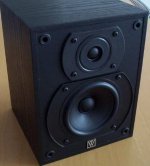 Wharfedale_Diamond_3_Drivers.JPG29.8 KB · Views: 299
Wharfedale_Diamond_3_Drivers.JPG29.8 KB · Views: 299 -
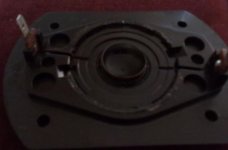 Wharfedale_Diamond_3_Tweeter_Plate.JPG30.2 KB · Views: 191
Wharfedale_Diamond_3_Tweeter_Plate.JPG30.2 KB · Views: 191 -
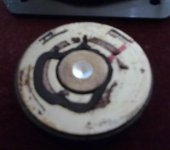 Wharfedale_Diamond_3_Magnet.JPG32.2 KB · Views: 180
Wharfedale_Diamond_3_Magnet.JPG32.2 KB · Views: 180 -
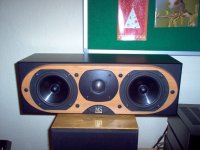 Mordaunt_Short_MS821C_Front.jpg91.4 KB · Views: 148
Mordaunt_Short_MS821C_Front.jpg91.4 KB · Views: 148 -
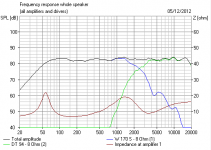 Wharfedale_Sim_FR.PNG20.5 KB · Views: 169
Wharfedale_Sim_FR.PNG20.5 KB · Views: 169 -
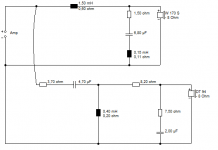 Wharfedale_Sim_Network.PNG11.6 KB · Views: 171
Wharfedale_Sim_Network.PNG11.6 KB · Views: 171 -
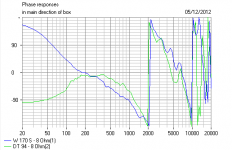 Wharfedale_Sim_Phase.PNG19.3 KB · Views: 180
Wharfedale_Sim_Phase.PNG19.3 KB · Views: 180
The 1.8mH will look like L1 in this pic. The 0.2mH will look like L3.
http://www.deviantpics.com/images/2012/11/30/2.jpg
The Diamond 3 xover is similar to Laser 90B but without the 0.05mH inductor. In its place may be a small resistor.
If the 0.2mH is missing, you need to replace it. If the treble units were blown, the treble capacitors will probably be blown too.
As sreten says, none of this is likely to give the correct response except with the genuine Wharfedale unit.
But it will be better than 6dB/8ve xovers (without the 0.2mH) which are truly evil.
I replaced all the caps. The change I made was to replace the two in series, giving 1.6uF, with a single 4.7uF cap (bearing in mind that I changed 8Ohm tweeter for a 6Ohm unit). There is a resistor in the circuit, measured at 2.5Ohm, couldn't decipher what was printed on the actual resisitor.
Interesting pics and data, Steve. My Diamond look pretty much the same as you've posted- and the dead tweeter also looked much like the pic you've posted, fluid leaking and magnet fallen off. My crossover network is simpler than the Laser schematic although I see Wharfedale also uses the 450uF cap on the woofer.
- Status
- This old topic is closed. If you want to reopen this topic, contact a moderator using the "Report Post" button.
- Home
- Loudspeakers
- Multi-Way
- Wharfedale crossover question